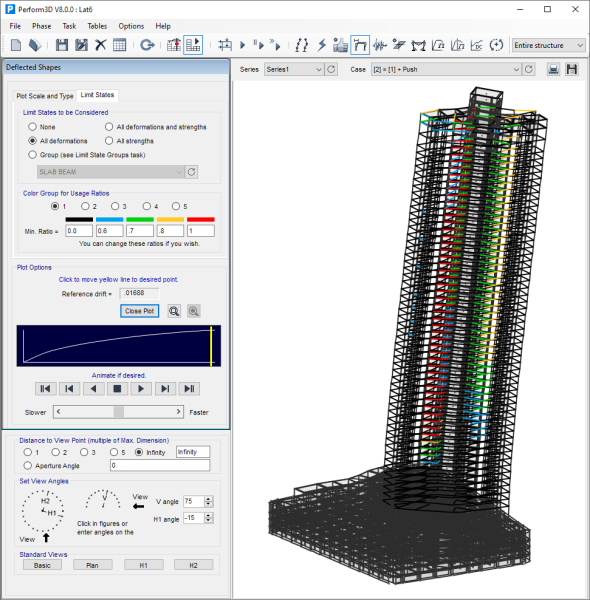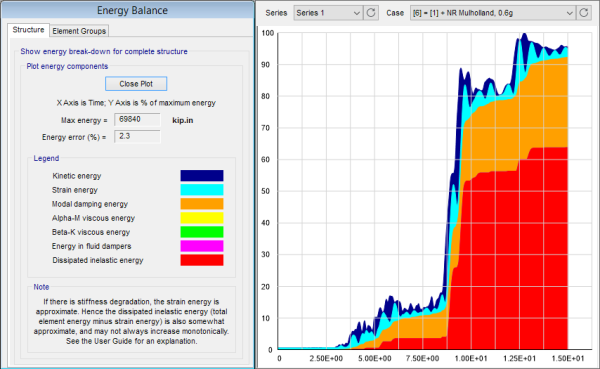Overview:
 CSI Computers and Structures, Inc. (CSI) created Perform3D, a specialist program meant for nonlinear performance-based analysis of structures subjected to seismic stresses. For engineers who need to know how buildings would fare in severe seismic occurrences, it is an effective tool since it concentrates on assessing the behavior of complex structures beyond elastic limits. CSI Perform3D’s Full Version , intricate modeling of structural elements such as base isolators, dampers, and plastic hinges is possible, providing more realistic simulations of real-world behavior.
CSI Computers and Structures, Inc. (CSI) created Perform3D, a specialist program meant for nonlinear performance-based analysis of structures subjected to seismic stresses. For engineers who need to know how buildings would fare in severe seismic occurrences, it is an effective tool since it concentrates on assessing the behavior of complex structures beyond elastic limits. CSI Perform3D’s Full Version , intricate modeling of structural elements such as base isolators, dampers, and plastic hinges is possible, providing more realistic simulations of real-world behavior.
CSI Perform3D Latest Version is a nonlinear analysis and design tool that specializes in building capacity and displacement design. Numerous nonlinear architectural elements, such as braces, dampers, shear walls, frame hinges, and seismic isolators, are examples of nonlinear features. Dynamic earthquake analyses and nonlinear pushover are two performance-based design tools offered by the Perform3D analysis engine. The product can perform up to eight analyses in parallel thanks to its 64-bit analysis engine.
CSI Perform3D Full offers several tools for evaluating the behavior of the structure and measuring the model’s response, such as strain gage elements and definitions of strength and deformation capacity for both elastic and inelastic components. Perform3D’s limit state feature facilitates performance assessment by combining response data into demand-over-capacity ratios. Perform3D models are a good place to start when creating your model; they can be exported from ETABS or SAP2000.
You may also like: Download CSI SAP2000 Ultimate
CSI Perform3D 9.0.0 Key Features:
Modeling:
- Frame View: A Frame view in CSI Perform3D Pre-Activated may be used to show only specific portions of the structure, which helps to simplify and organize the structure’s description and display. When designing the model, you may rapidly switch between a view that shows the entire structure and a view that just shows the pieces in frame view.
- Import from SAP2000 and ETABS: CSI Perform3D Activated models are a good place to start when creating your model; they can be exported from ETABS or SAP2000.
- Import of Structural Geometry Through Text Files: A text file with commas separated in it may be used to import nodes, element geometry, masses, and nodal loads.
Elements and Components
- Perform3D includes the following element types:
• Support components, such as columns, beams, and braces.
• Shear wall component for walls.
• The flooring slab component.
• Gap and hook elements are examples of axial-only bar elements.
• Rubber and friction pendulum type seismic isolators.
• Brace with buckling restraint.
• An infill panel that is solely stiff and strong.
• A fluid damper in which the force and deformation rate have a nonlinear relationship.
• Connection panel zone: used to simulate shear deformation in connections between beams and columns.
• Different kinds of “Gages” of deformation. These components are used for reporting and performance evaluation; they are not stiff. - Customize frame element properties through the use of multiple elastic and inelastic components in a compound component: Frame elements in Perform3D consist of several parts, including releases, end zones, elastic sections, and nonlinear hinges. A nonlinear column, for instance, could be made up of multiple parts.
Inelastic Components:
- Trilinear backbone curve with energy degradation: The force-deformation relationship of inelastic components can be either tri-linear or elastic-perfectly-plastic, with strength loss being an option. To take stiffness degradation into account, one can alter the hysteresis loop for an inelastic component. To make sure the hysteresis loop has the desired form, it may be displayed as the component characteristics are being defined.
- The following inelastic components are among those available in Perform3D:
• Nonlinear steel and concrete materials, such as steel that buckles
• Nonlinear beam M3 and V2 hinges
• Coupled P-M2-M3 and V2-V3 nonlinear hinges for columns
• Nonlinear fiber components for columns and beams
• Elastic or inelastic shear behavior and nonlinear P-M3 fiber sections for shear wall modeling
Response Measures:
- Limit States: There may be a very big number of components with D/C ratios. Components with comparable D/C metrics can be grouped into Limit States to facilitate decision-making. Strength D/C ratios may be used to verify that elastic components have enough strength to stay elastic, whereas deformation D/C ratios can be used to verify that inelastic components have adequate ductility.
- Limit states can be defined using the following response measures:
• Deformation capacities of components
• Strength capacities of components
• Capabilities for strain gage deformation
• Sections on drift, deflections, and structure
Load Cases and Analysis:
- Analysis Series:
- Analyses in Perform3D are a component of an analysis series. The following structure properties can be altered for each analysis series:
• The magnitude and distribution of mass. Both dynamic response history analysis and static push-over analysis may be impacted by this.
• The type and quantity of damping used in the analysis of dynamic response history.
• The stiffnesses and strengths of structural components whose component properties have the Upper/Lower Bound feature activated. - Analysis Types:
- Perform3D can run the following analysis types:
• Effective mass factors, periods, and mode shapes
• The weight of gravity
• Push-over that is static
• Ground motion response history during earthquakes
• History of responses to dynamic forces
• Analysis of response spectrums
Behavior Check:
- Deformed Shapes: For both static push-over and dynamic response history analysis, these can be animated.
- Moment and Shear Diagrams: Shear wall, column, and beam moment and shear diagrams that are animated.
- Hysteresis Loops for Inelastic Components: Force-deformation plots of all inelastic components, such as dampers, hinges, and isolators, can be viewed and used to verify the inelastic behavior after the analysis has been run.
- Time Histories: Time histories of numerous response quantities, such as forces on “structure sections” that cut through the entire structure or just a portion of it, node displacements, velocities, and accelerations, element and component forces, and deformations.
- Energy Balance, Showing Strain Energy, Kinetic Energy, Inelastic Work, and Damping Energy: This includes a comparison of the internal and external work, which offers a reliable indicator of the analysis’s numerical accuracy.
Performance Assessment:
- Target displacement calculation for pushover analysis: The FEMA 356 Coefficient Method can be used to calculate the target displacement.
- Usage ratio plots for single load cases: The usage ratios for the limit states gradually rise as the drift increases in a push-over analysis or as time increases in a response-history analysis. The usage ratio variations for user-selected groups of limit states are displayed in a usage ratio plot.
- Usage ratio envelopes for load combinations: It is standard procedure to perform response history analyses for multiple earthquakes (typically seven or more), and to evaluate performance by calculating the average usage ratios.
- Deflected shapes with color coding based on D/C ratio: These can be used to locate hot spots, or areas of extreme component deformation.
- Results Output and Database Tables: Performance metrics and tabulated analysis results are accessible in database tables: It is possible to export tabulated results to text, XML, Excel, and Access formats.
- Automated tabular output after analysis is complete: Each tabular output file’s output content can be restricted by specifying a Table Named Set and Table Selection Group.
CSI Perform3D 9.0.0 Changelog:
- Data Files and Analysis: The maximum number of parallel Analysis Series that can be queued and run has been increased from 32 to 50
- Bug Fixes: Issues reported by users have been corrected.
Screenshots:


How to install & Activate CSI Perform?
- CSI Perform 3D 9.0.0 downloaded package contains the setup for both 32-bit and 64-bit Windows operating systems (Choose according to your OS).
- Disconnect from the internet and also pause your Antivirus momentarily as the keygen will be detected as a threat to your Windows (But it is safe and tested by FullSofts).
- Now extract the package using WinZip or WinRAR and install CSI Perform 3D 9.0.0 using setup.
- After the installation, don’t launch the program, or close it if launched.
- Copy the Fix file to the installation directory and replace it.
- It’s done, Enjoy CSI Perform 3D 9.0.0 Full Version.









